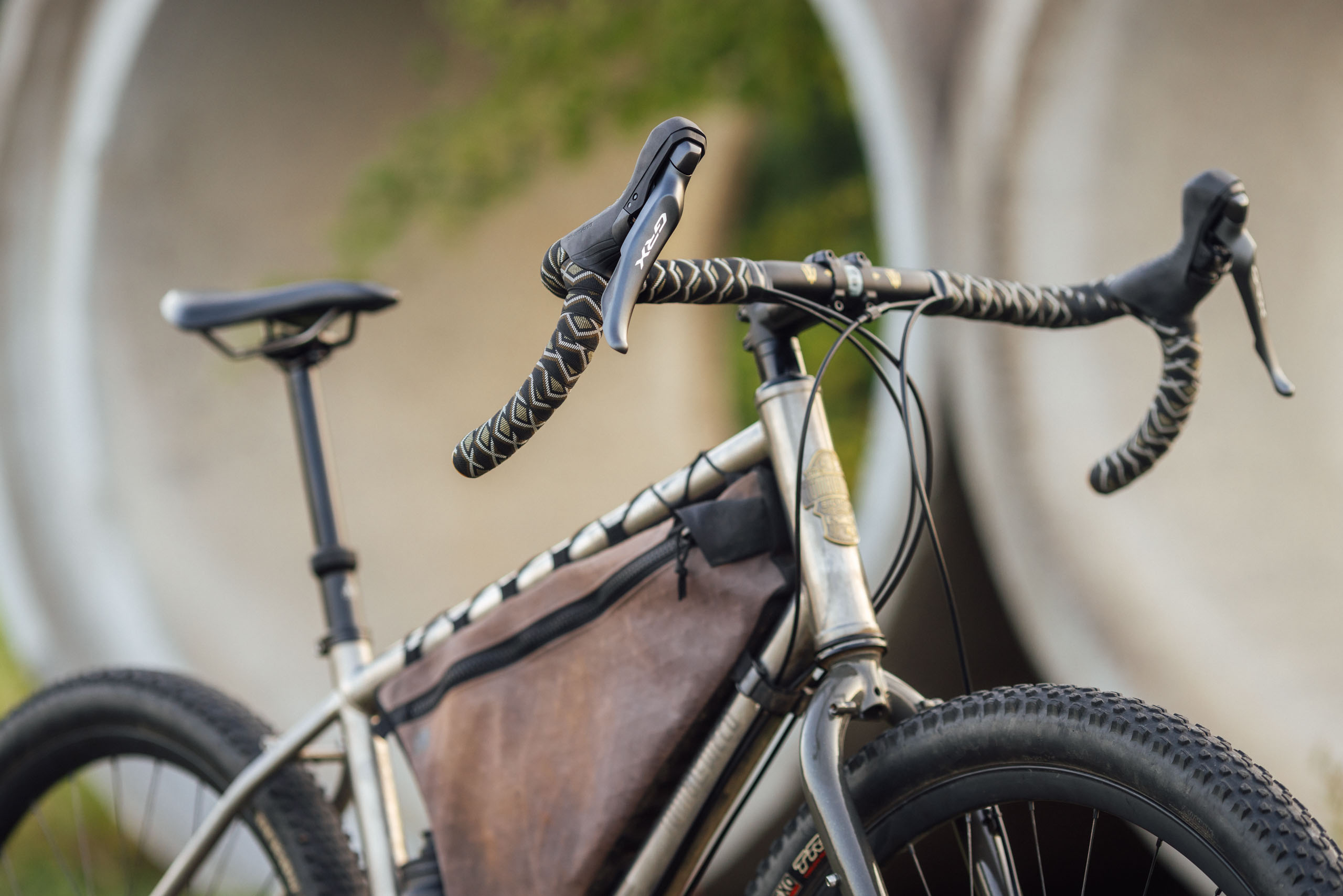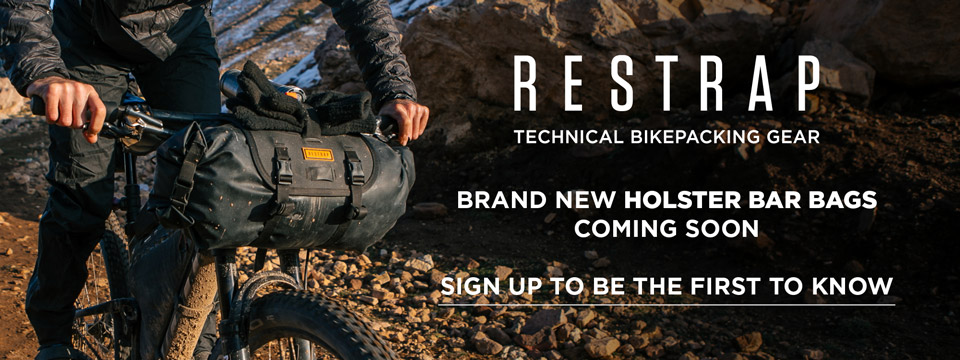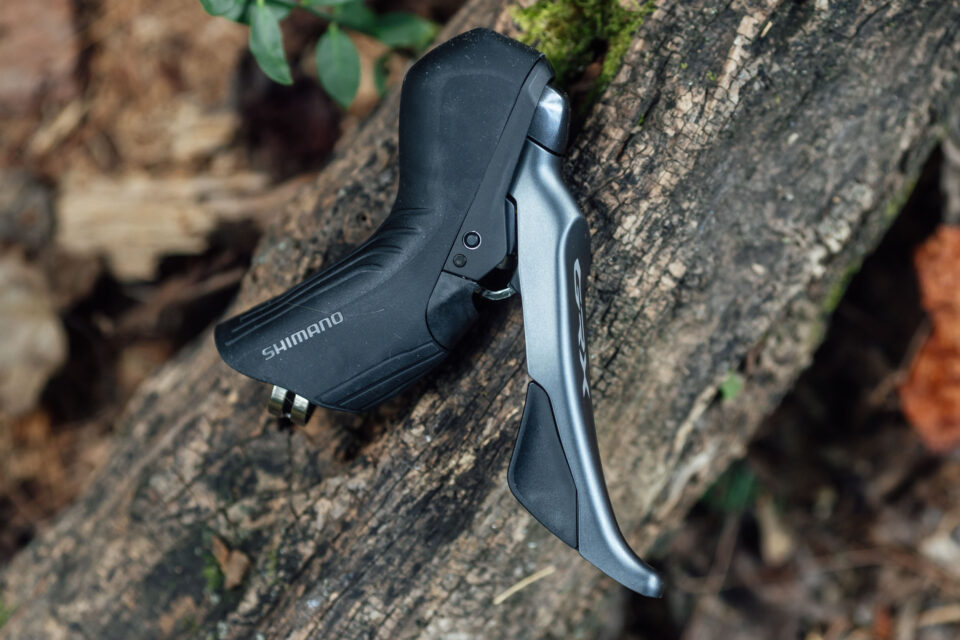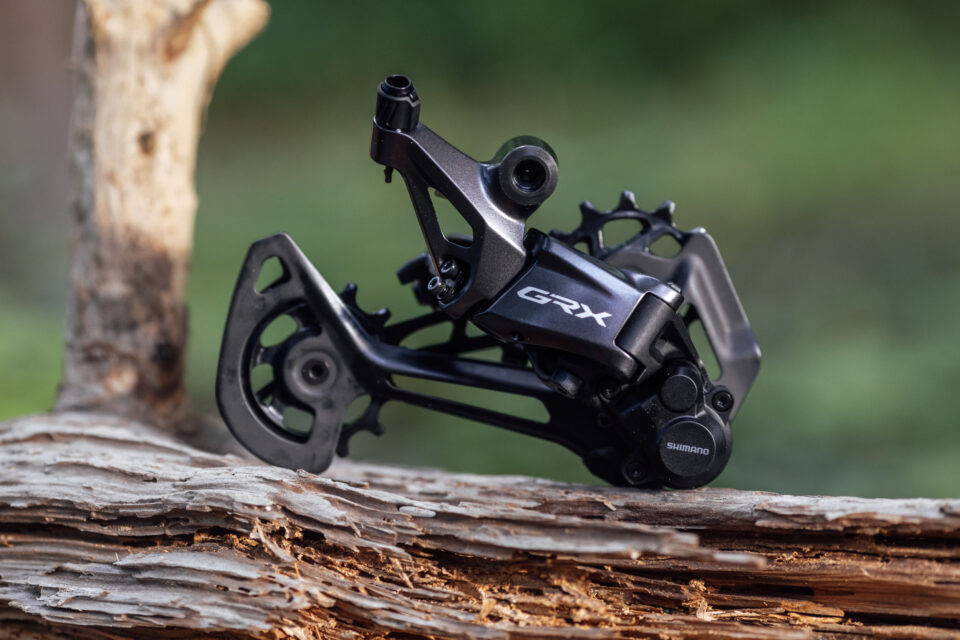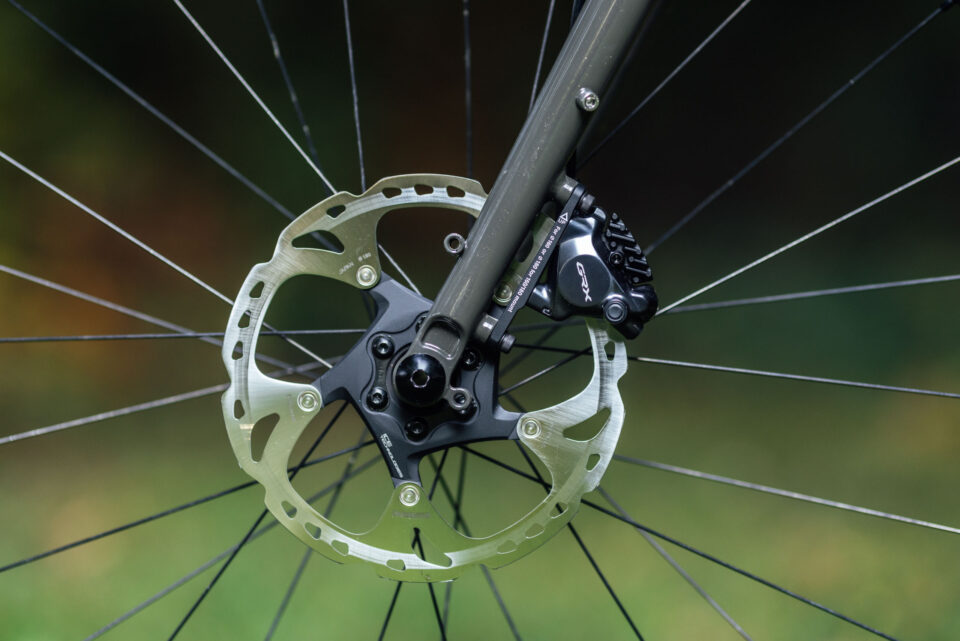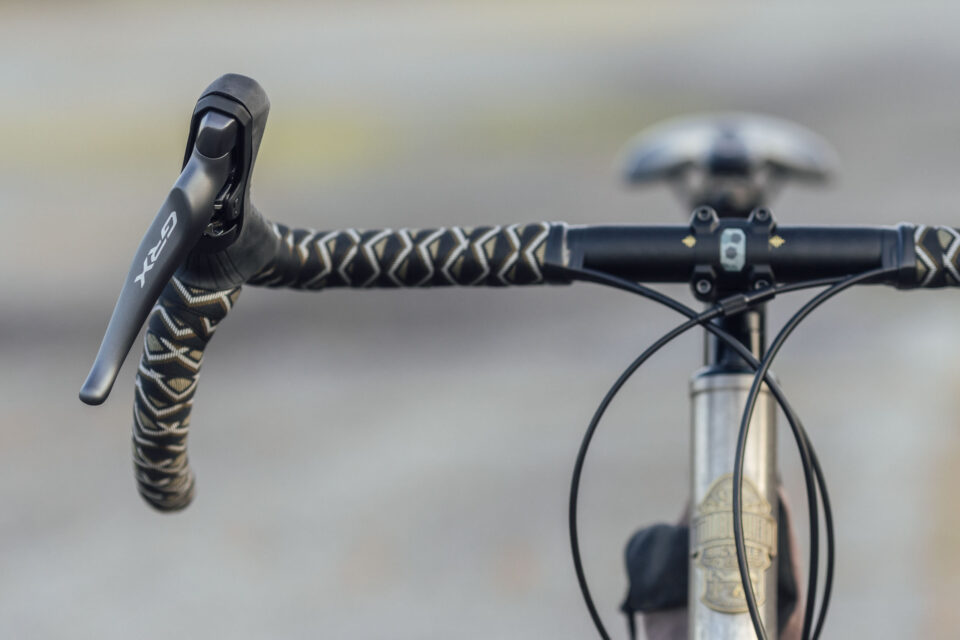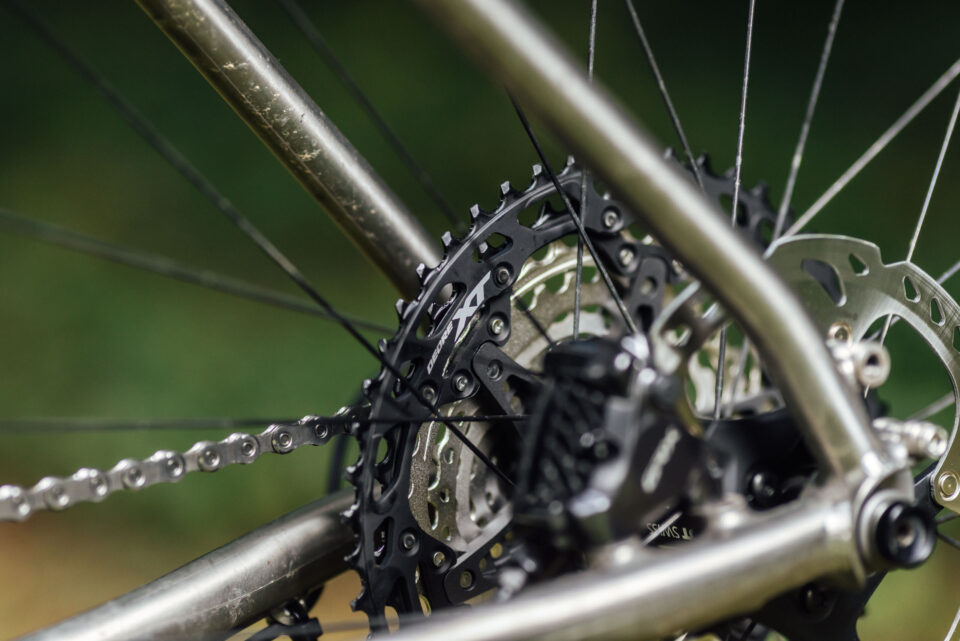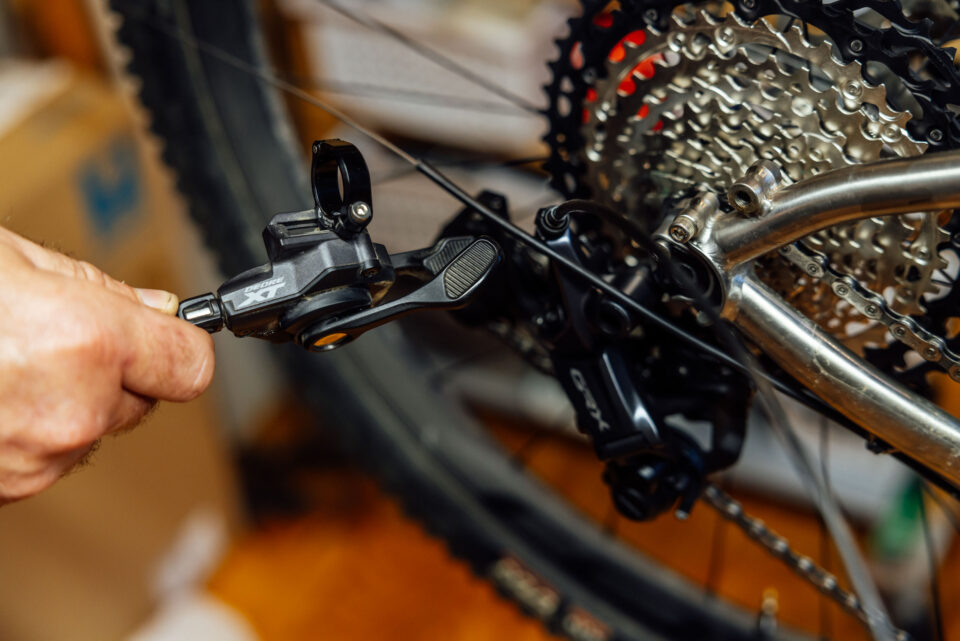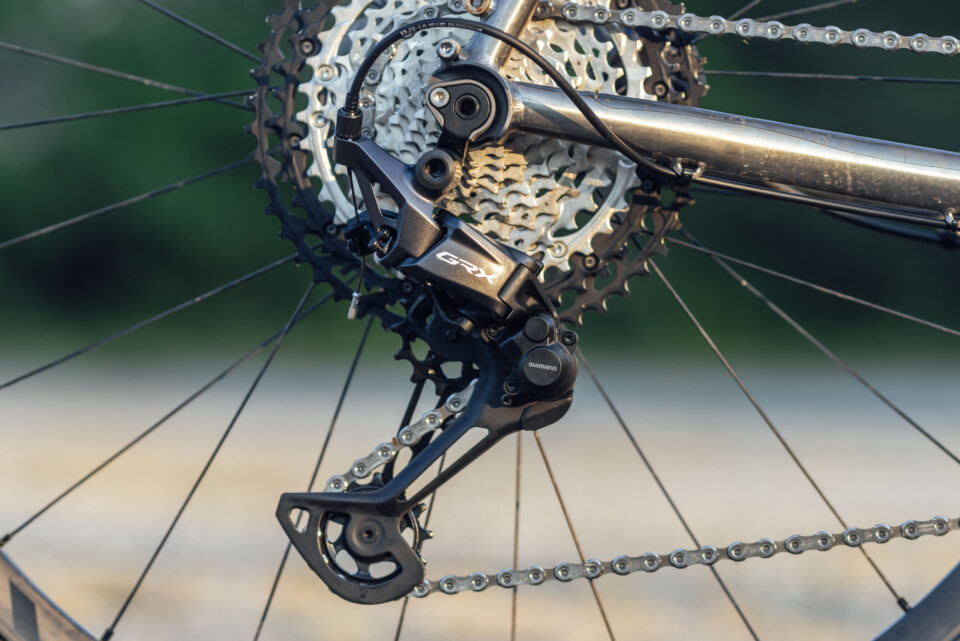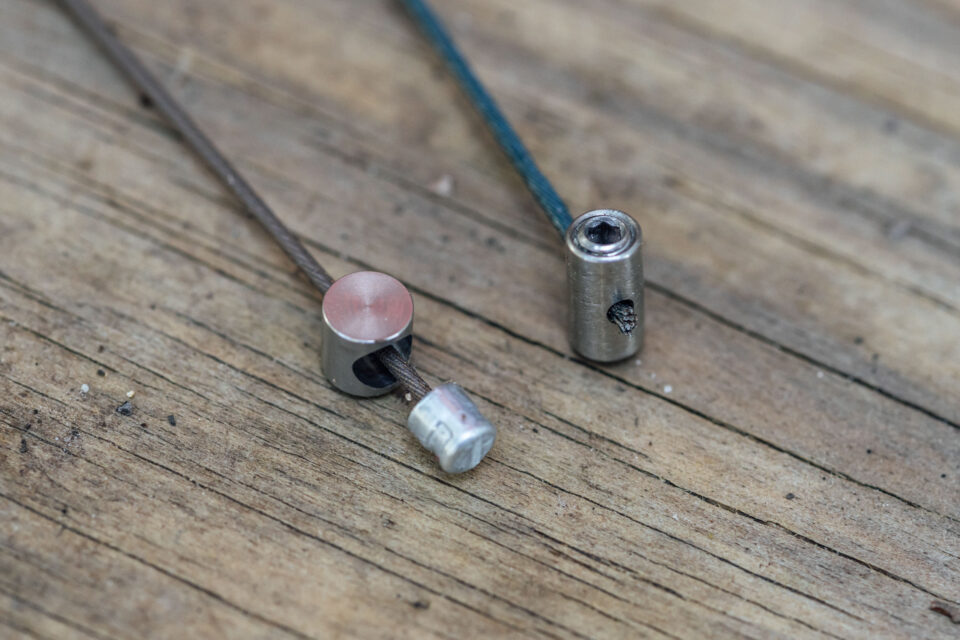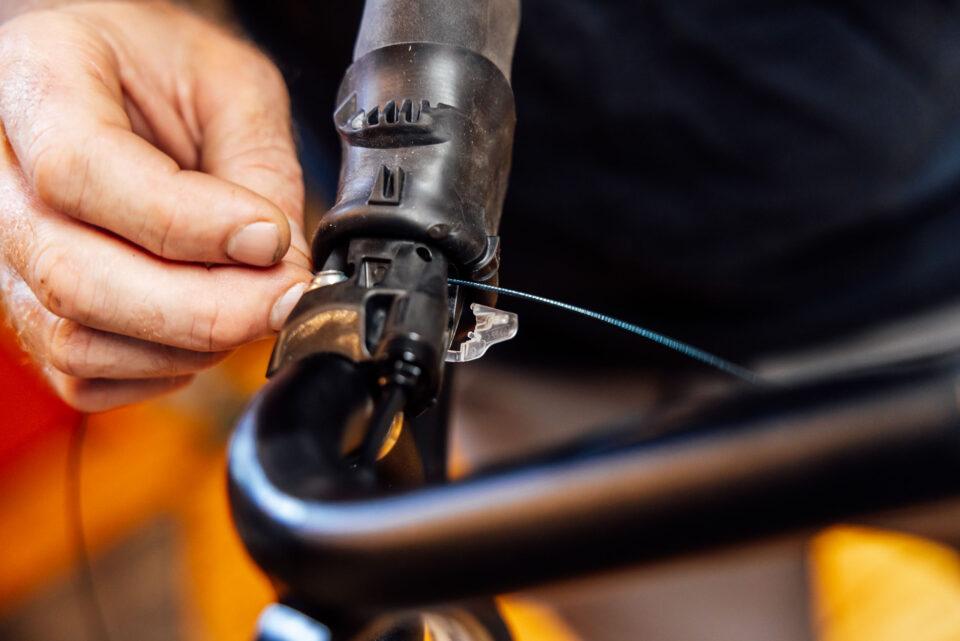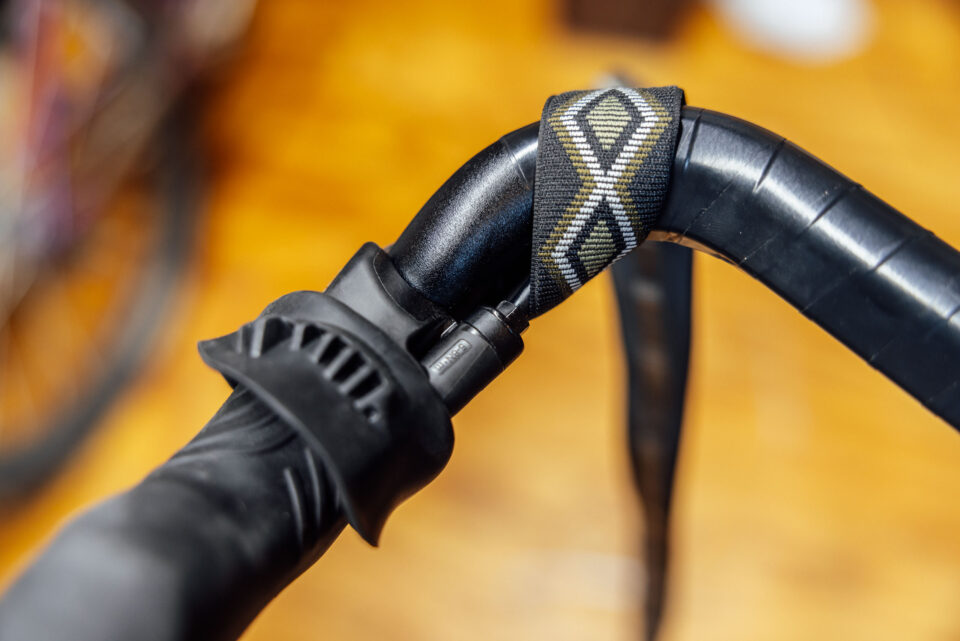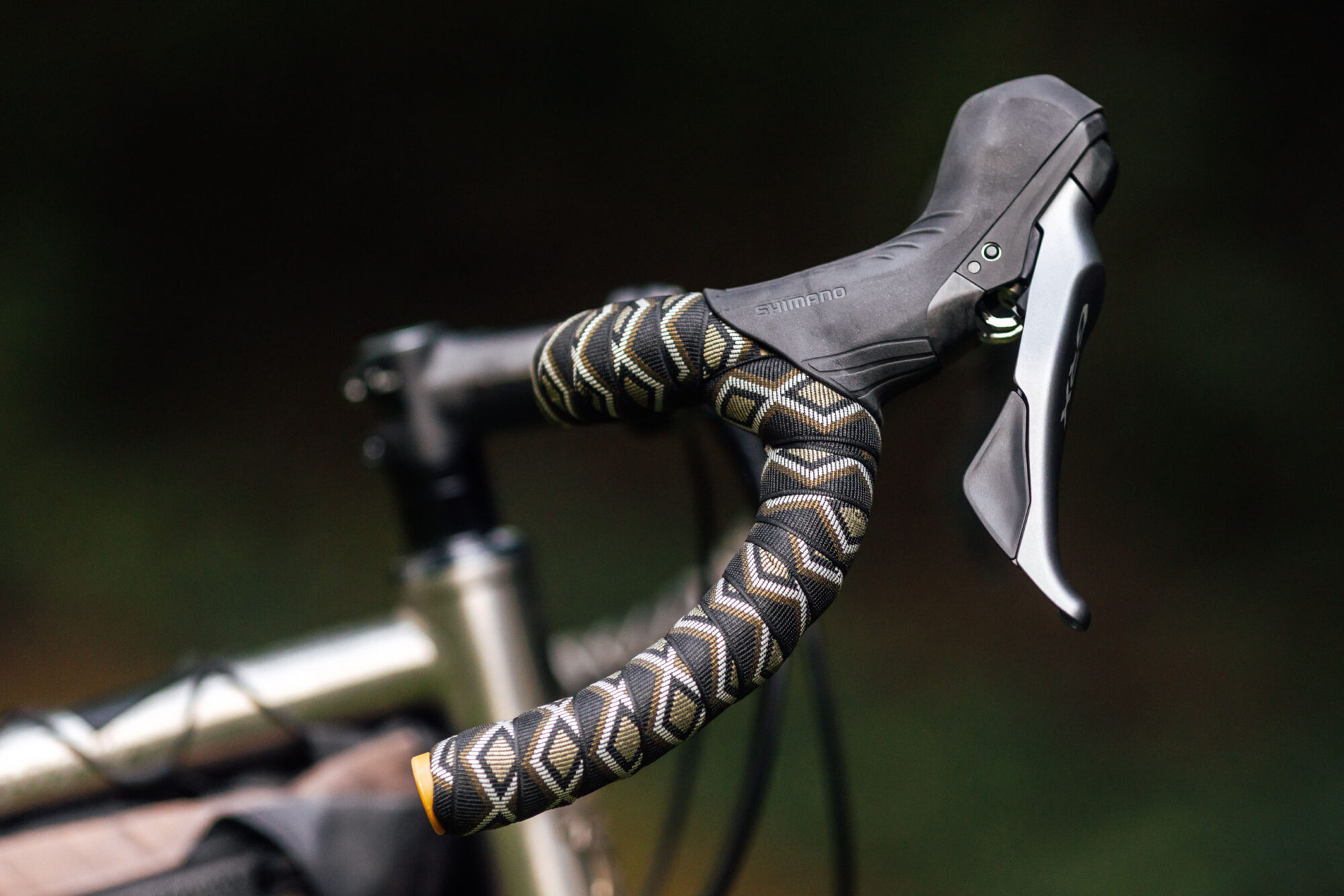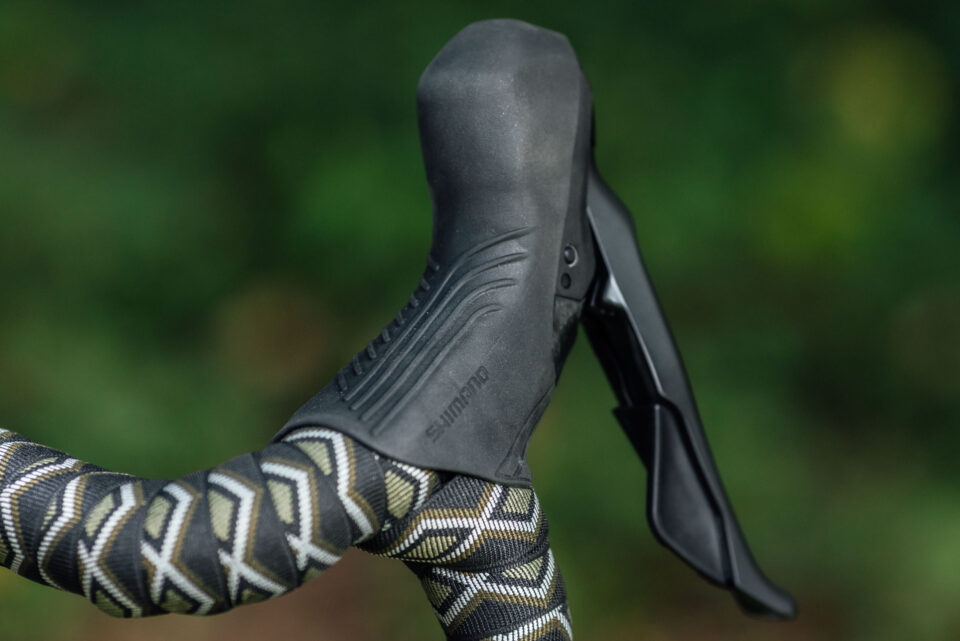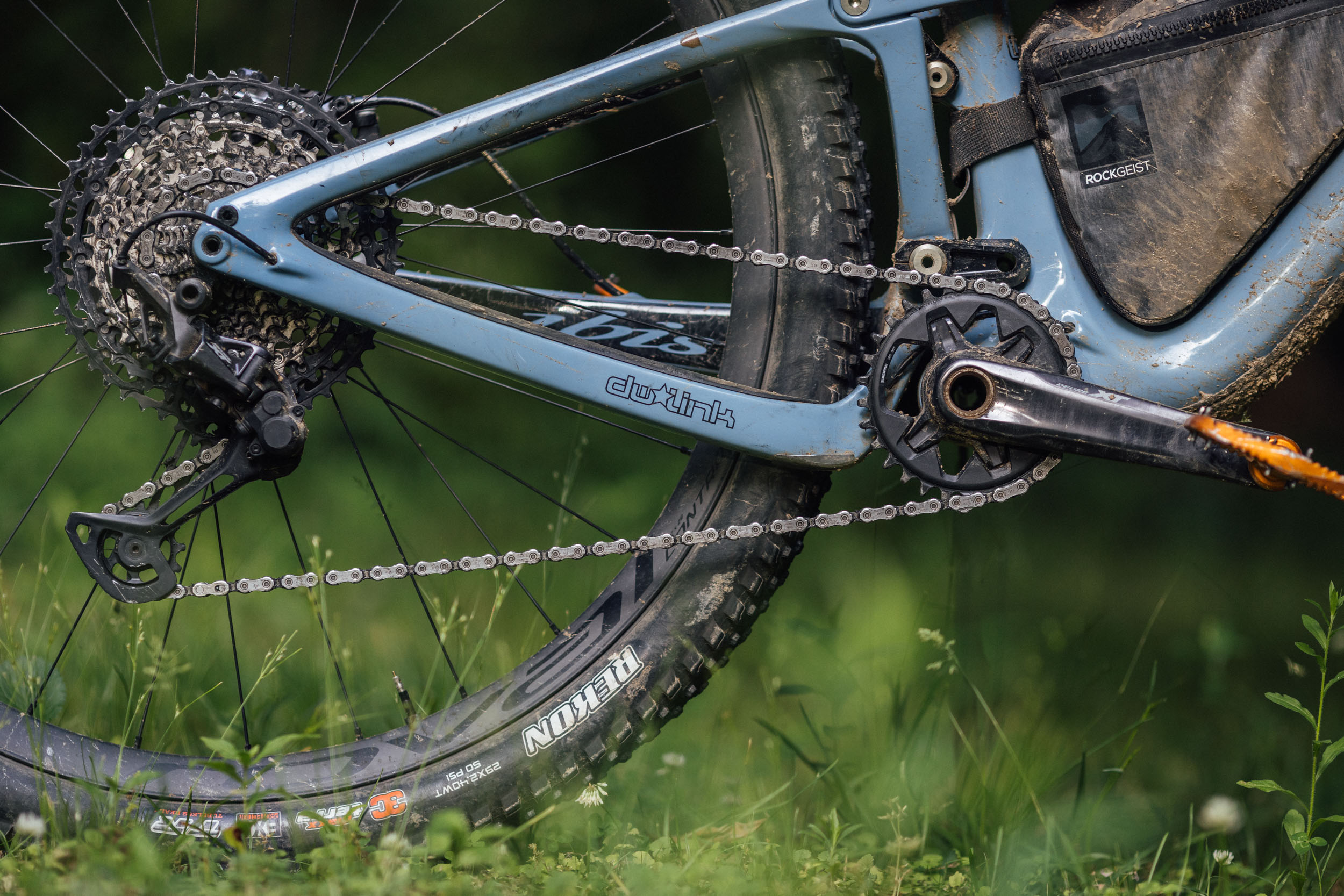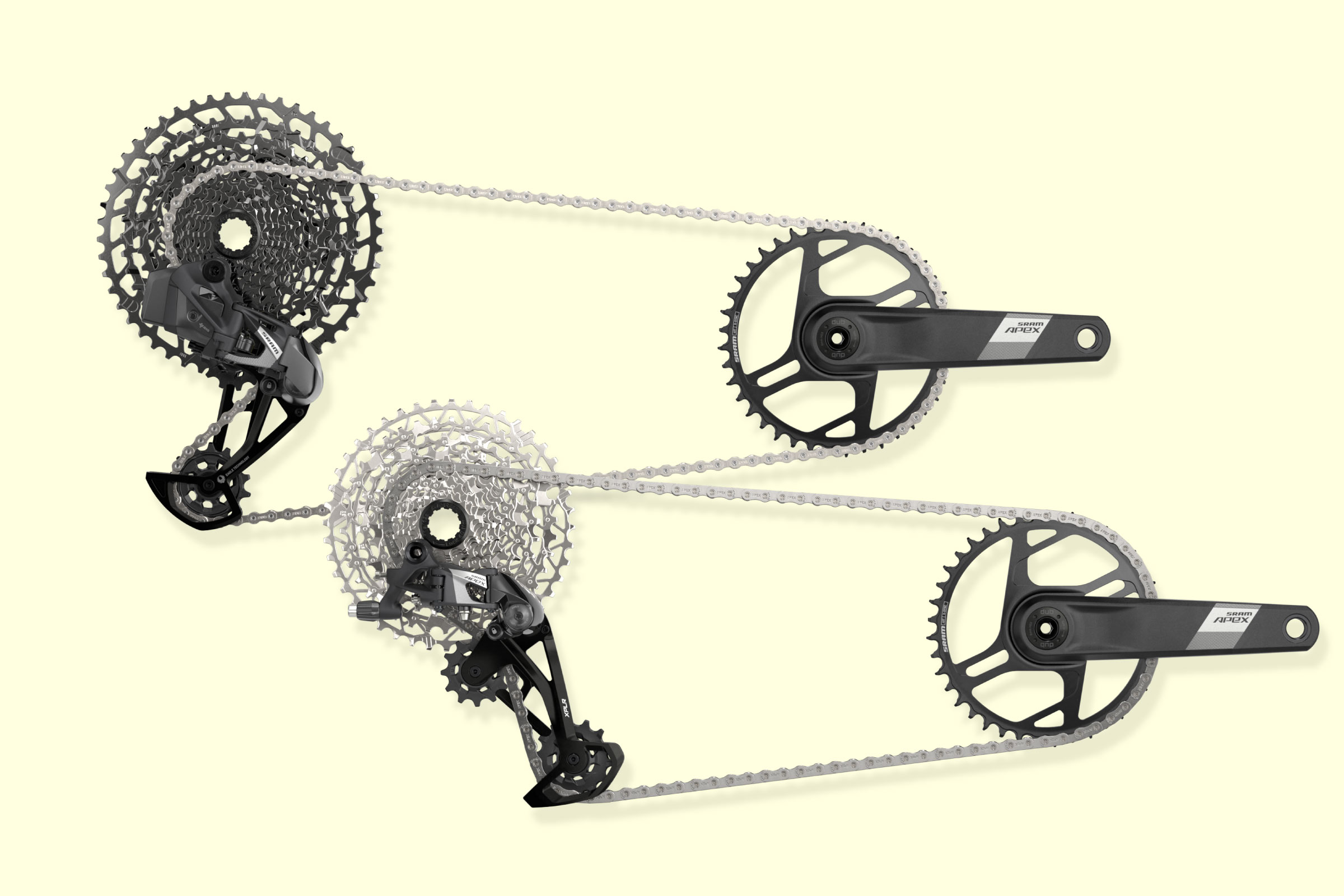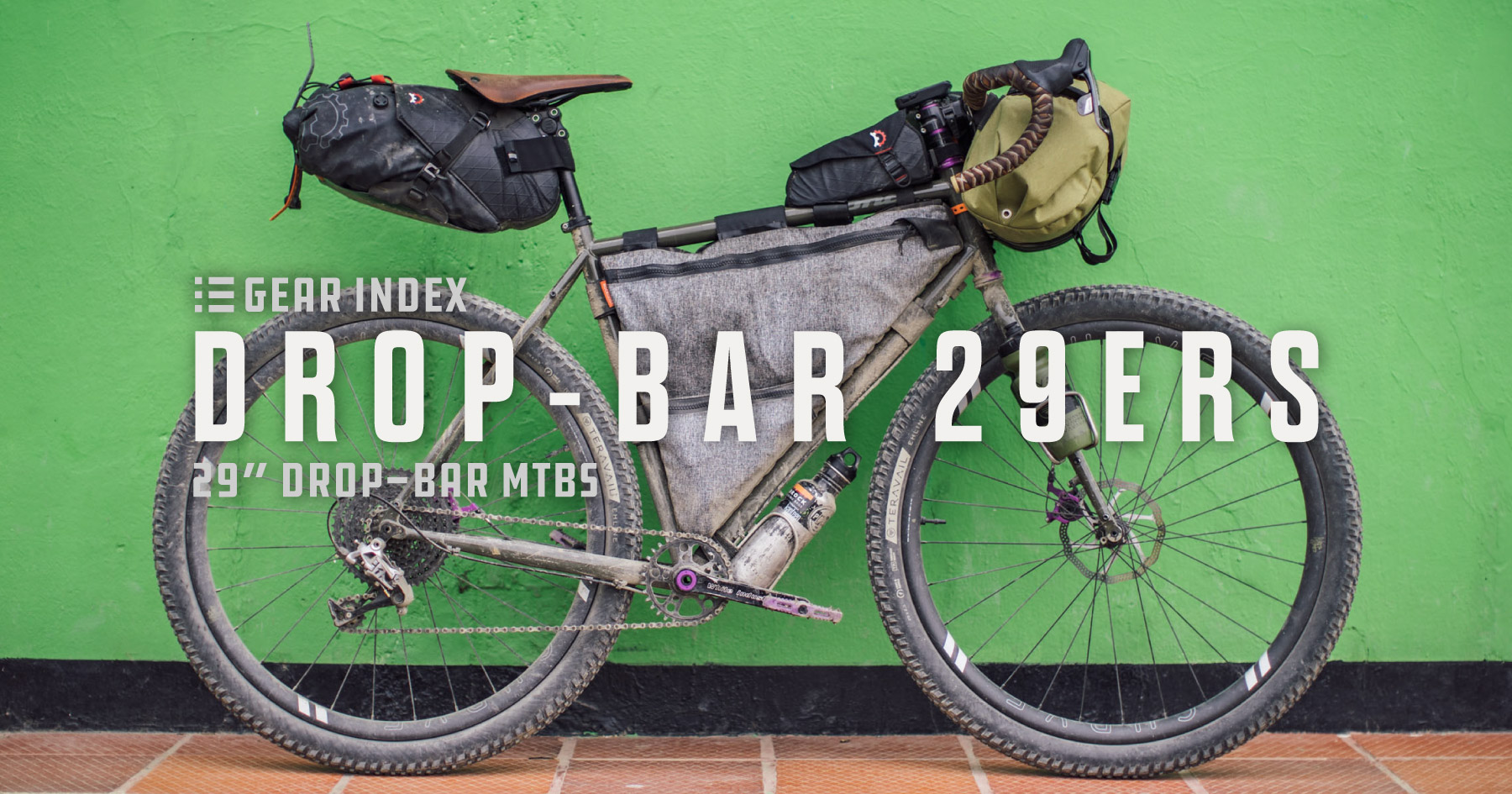Shimano GRX 12-speed Review: 800-series 1x
Terrified of wireless tech and new standards? We’re happy to report that the latest drivetrains from Japan are fully mechanical. The all-new Shimano GRX 12-speed 1x groups use the same cassettes as their mountain bike counterparts and feature a few new upgrades. We’ve been testing the 1×12 GRX 800-series drivetrain with a 10-51 tooth cassette and an integrated dropper lever over a couple of weeks for this review…
PUBLISHED Aug 31, 2023
If you’re anything like me—fearful that a new drivetrain announcement will come complete with a black hole of compatibility issues and a new freehub standard—you’ll be glad to hear that the new Shimano GRX 12-speed drivetrains are built around cable-operated derailleurs that work with existing cassettes and freehubs. That’s not to say that everyone will agree with all the nuances rolled into the latest GRX groups, but the pros largely outweigh the cons. I’ve been testing the 1×12 800-series group for a couple of weeks ahead of today’s launch, which also includes a 2×12 groupset and several more affordable component options. Read on to learn more about what Shimano has been up to, plus find a detailed review of the new Shimano GRX 1×12 group tested with a pie-plate mountain bike cassette.
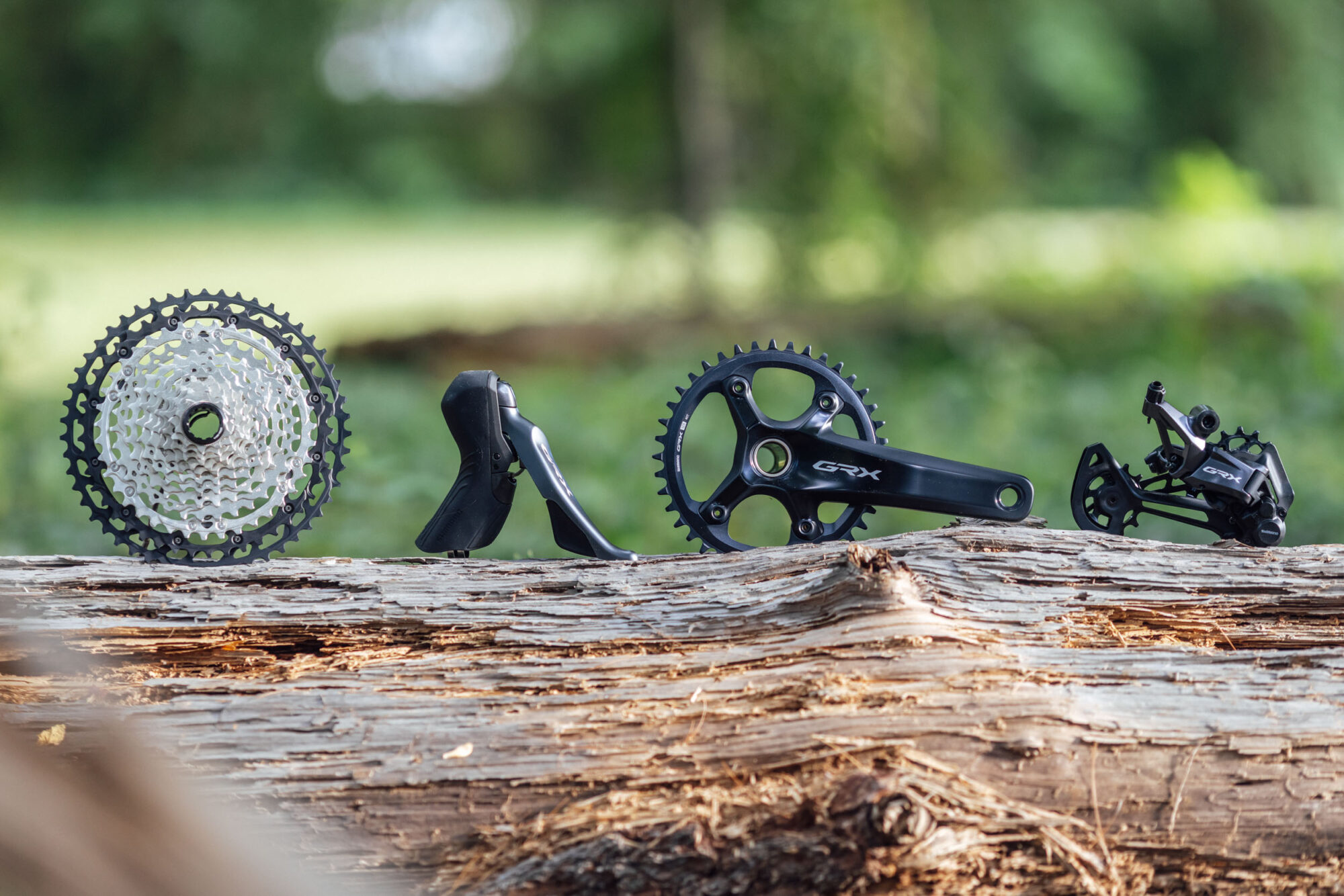
Shimano GRX 12-speed Groups
Shimano GRX 12-speed 800 Series
Shimano unveiled three top-tier mechanical GRX 12-speed groupsets with this launch—kind of. To summarize, it’s really three new 12-speed GRX rear derailleurs that define three suggested 800-series group setups. In addition to the three RDs, there are new brake/shifter levers, two new cranksets, and a front derailleur. However, Shimano appropriated several existing cassettes from their road and mountain bike lineups for this range of options.
Instead of naming each of the three setups with numeric combinations or acronyms, Shimano used slightly awkward and marketing-forward adjectives to define them: (1). “Unbeatable” is how they refer to the 1×12 setup with the new RD-RX822-GS medium cage rear derailleur paired with the 10-45T mountain bike cassette. It’s marketed to racer types and folks interested in going fast; (2). “Unstoppable” refers to the same 1×12 levers paired with the new RD-RX822-SGS long cage derailleur and a 10-51T cassette (CS-M8100-12) borrowed from their mountain bike group. That’s what I’m testing, and it’s marketed toward all-day rides or multi-day adventures; and (3). Then there’s the 2×12 “Undroppable” groupset…
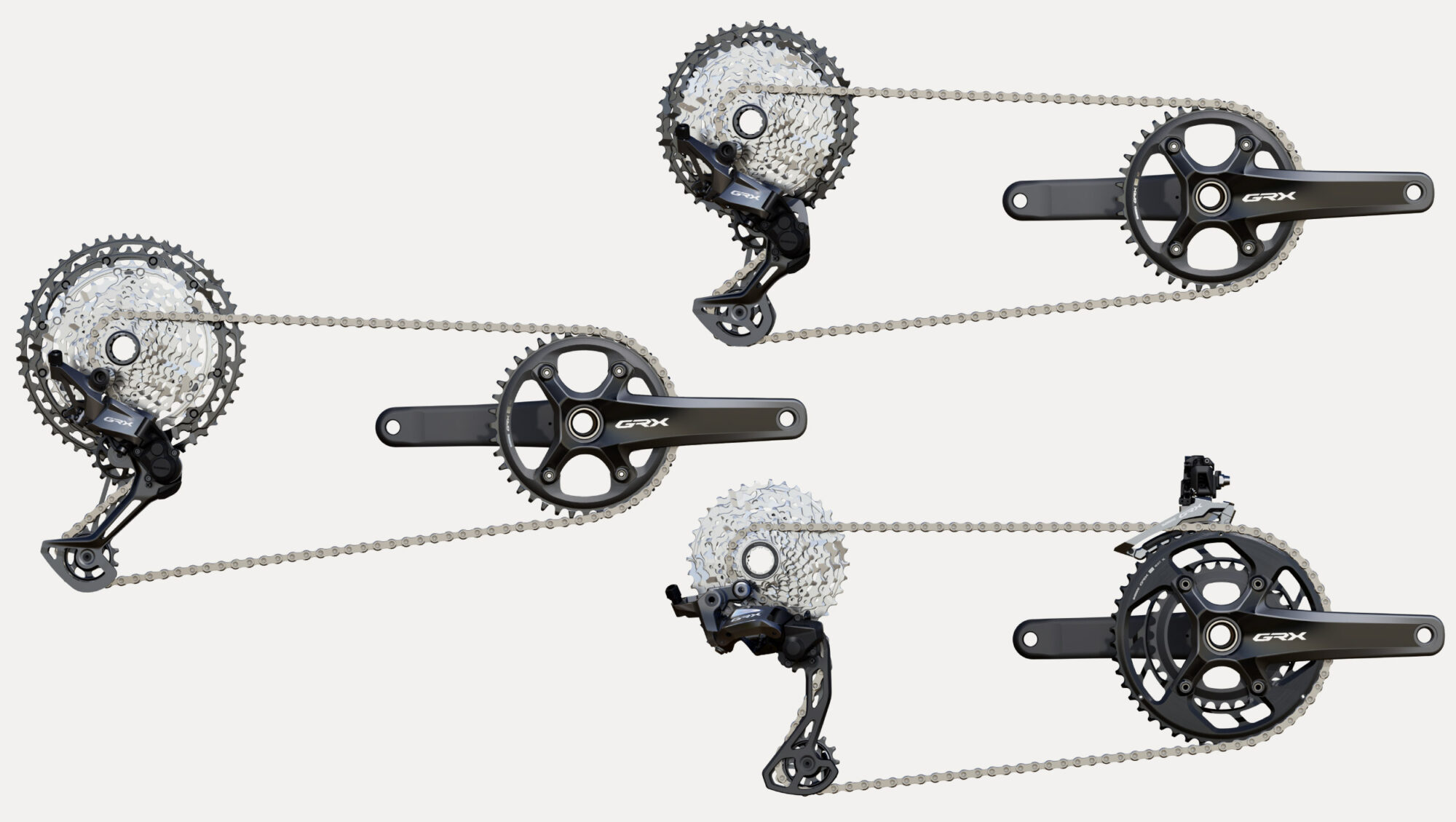
2×12 and 600-series
I won’t go too far down this rabbit hole since I’m reviewing the 1×12 GRX drivetrain, but it’s worth quickly outlining the “Undroppable” 2×12 GRX bits and bobs. In summary, this group has a new 12-speed rear derailleur (RD-RX820) with a maximum cassette cog size of 36T. There’s also the new FD-RX820 front derailleur and the FC-RX820-2 crankset with only one option for a chainring combo: 31/48. They pair this with two cassette options, both of which previously existed in the Ultegra and 105 road ranges: either the 11-34T (CS-R8100-12) or the 11-36T (CS-HG710-12), which nets a 506% gear range.
Some of you will remember Shimano’s 12-speed Dura-Ace announcement, which actually happened exactly two years ago today. With that, they mentioned a new freehub standard that was referred to as “road spline” in some reports. Shimano references this again in today’s release but refers to it as HG L2, or Road 12-speed Dedicated, which has 18 splines instead of nine like on standard HG or 23 on MicroSpline. Both the road 2x cassettes will mount to either a standard HG driver or the new HG L2.
Shimano also rolled out new 12-speed 600-series cranks and shift levers for 1×12 and 2×12 setups that borrow trickle-down technology from the 800-series components. The 1x crankset (FC-RX610-1) weighs about 175 grams more than the 800-series version and retails for $159.99. The 2x FC-RX610-2 Crankset is specced with a 46/30 chainrings and retails for 159.99. There are also 1×12 levers (542 grams/$664.98) and 2×12 levers (611 grams/$679.98). Lastly, Shimano also released the RX880 gravel wheelset with a direct engagement hub and 25mm internal width carbon rims.
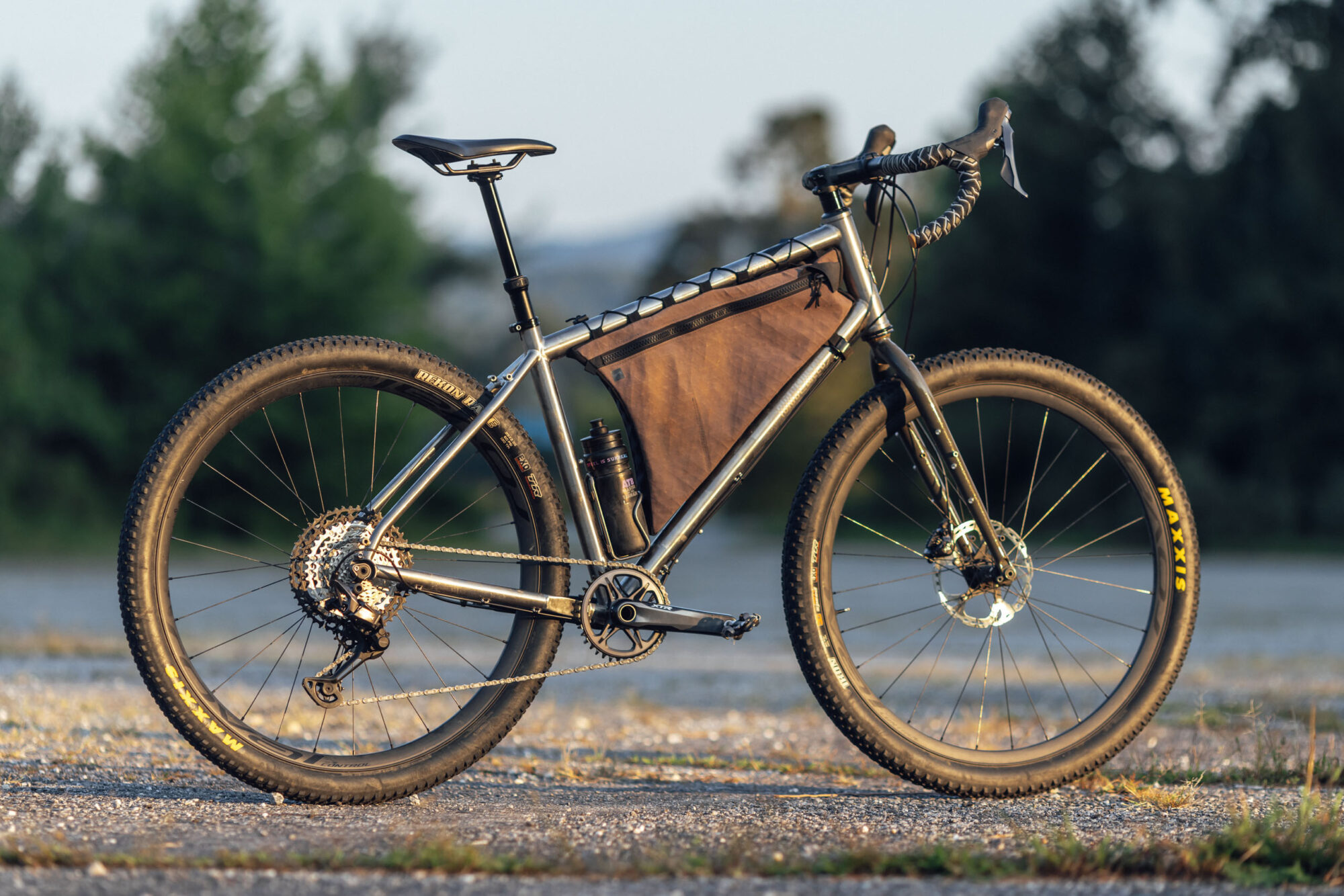
Standards Schmandards
Not everyone’s going to love the fact that the GRX 1x stuff is now married to the MicroSpline freehub, despite that it’s now a five-year-old new norm in the mountain bike world. However, the fact that Shimano went this route with their gravel group shows the brand’s commitment to the platform. I expect MicroSpline is here to stay—for a while, at least. Hell, the classic HG freehub hasn’t changed since it was introduced back in 1978.
One certainty is that a lot of folks will be bummed that these groups are only available with flat mount brakes, me included. You can retrofit them to work on post mount with various post-to-flat adapters like this one from Wolf Tooth Components. EDIT: Shimano let me know that their 2-piston MTB post-mount calipers are compatible with these levers. Still, I wish there was a mechanical brake option for the ability to run a set of Klampers or Spyres. And then there’s the elephant in the room question…
Will the GRX 12-speed rear derailleur work with a Shimano 12-speed mountain bike shifter?
Sorry, but the answer to that is a hard no. When we were setting up this drivetrain, I happened to have an XT shifter freshly pulled from another bike, so we tried it before hooking up the GRX levers. It took all of five shifts to realize that the pull ratio was off. That means no seamless switching between drops and flat bars—at least until someone comes out with a hack, which will likely be in the form of an inline pulley. That said, with hydraulic flat mount brakes, things are already a bit complicated in that regard.
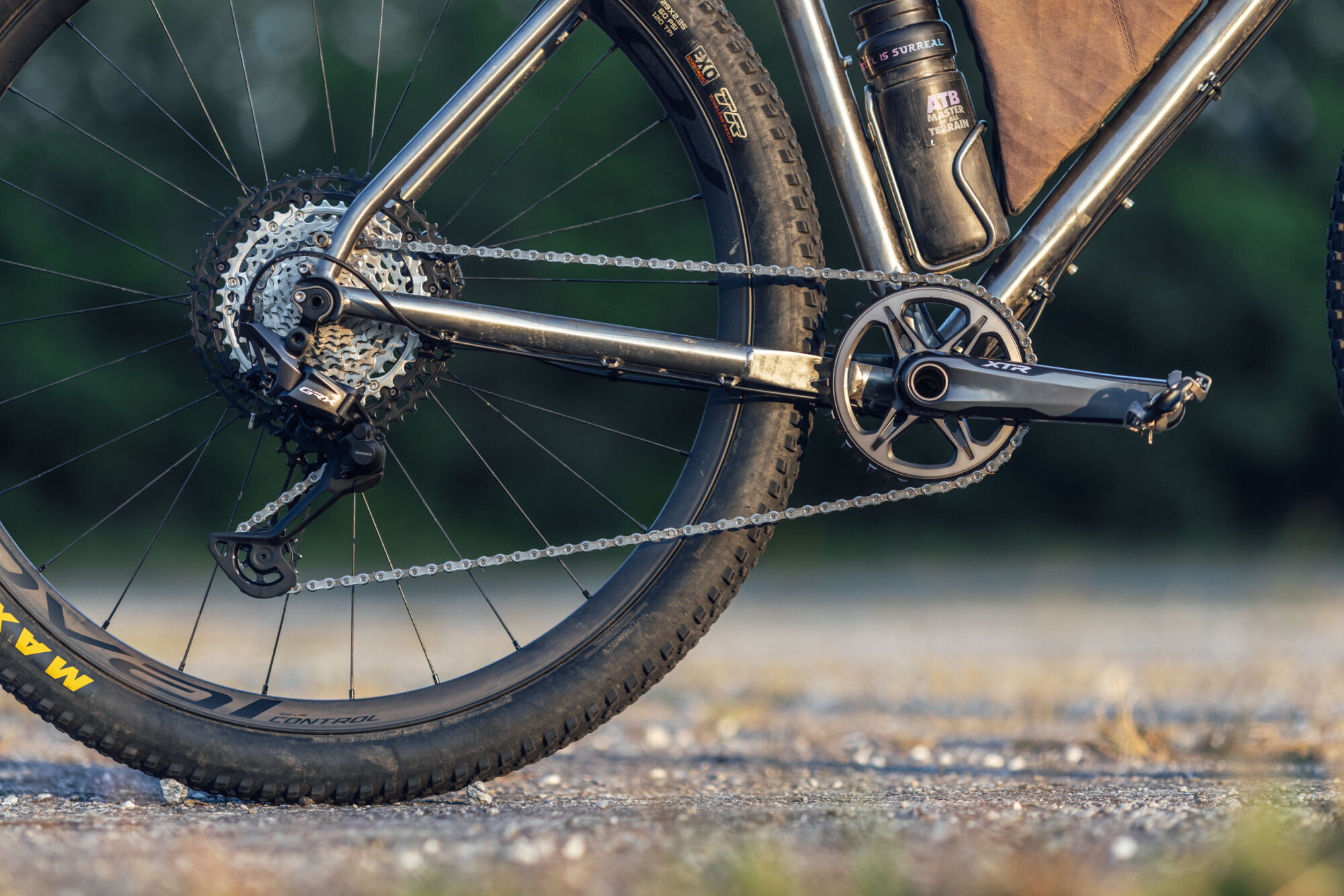
What about Boost?
The standards calamity I faced was with the crankset. Shimano sent the new GRX cranks, which are nice enough in person, but they’re designed to work only with a standard width road bottom bracket—a 68mm BB shell for BSA threaded. It doesn’t have a long enough spindle to work on my 73mm non-gravel “gravel” bikes. Both my Kona Sutra and Tumbleweed Stargazer have 73mm bottom brackets, and the Stargazer has Boost hub spacing. This isn’t a problem if you know in advance, of course.
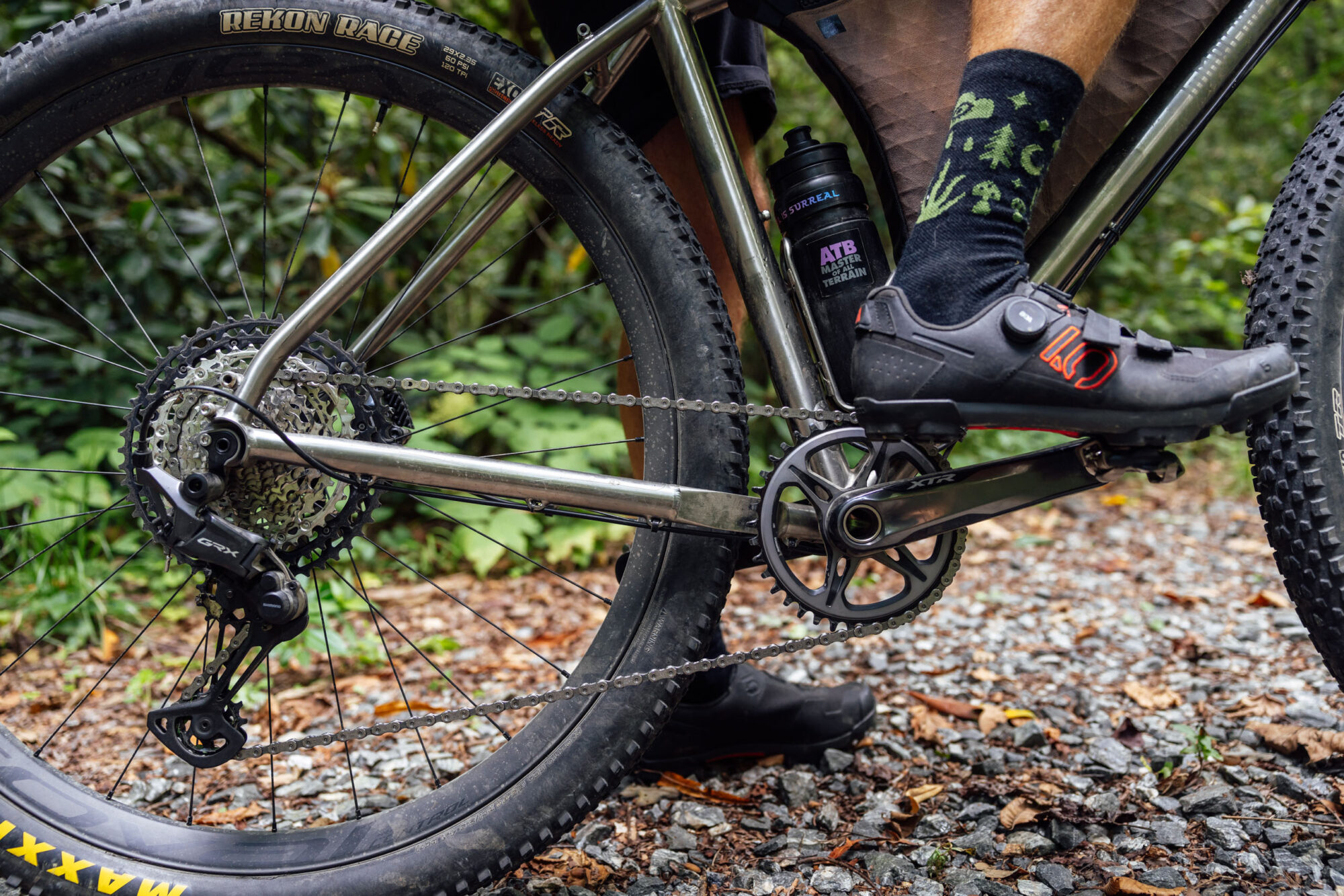
Cross-Compatibility (Mix and Match)
With that in mind, there are plenty of options for utilizing different parts for a drop-bar mountain bike. You can simply get an SLX, XT, XTR, or any other MTB crankset that can accommodate a Shimano 12-speed chain-friendly chainring. As many of you know, Shimano 12-speed chains are a little finicky in that respect. Several chainring manufacturers offer compatible options, such as the Wolf Tooth Drop Stop ST rings. And others suggest you can use their chainring but substitute an Eagle masterlink, such as White Industries. I used an XTR mountain bike crankset (FC-M9120), which according to Shimano is compatible with 142 and 148 Boost rear end spacing.
Considering the GRX 12-speed derailleur(s) works with a standard 12-speed MTB cassette, there’s also no reason why you couldn’t forego Shimano components and make it work with a third-party cassette, such as Garbaruk’s 12-speed cassette. And if you wanted to utilize a different freehub other than MicroSpline, you could use a Shimano Deore 12-speed cassette with a standard HG driver or even a SRAM chain and cassette with an XD freehub, although I haven’t tested such a franken-drivetrain, and you might not get the crisp and quiet shifting that I’ll touch on later in this review.
Actual Weights and Prices
Digging into the standard “Unstoppable” 1×12, 10-51T GRX setup that’s slated for big-ride gravel bikes, I put together a table of actual weights of the components I have on test. Note that I didn’t factor in two substitutions that were needed for my build (an XTR crankset for the 73mm BB shell and a 180mm front rotor).
| Component | Part # | Weight | Price |
|---|---|---|---|
| Shimano GRX 12spd Derailleur | RD-RX822 |
10.4
294 g
|
$126.99 |
| Shimano GRX Crankset (38t/170mm) | FC-RX820-1 |
22.6
640 g
|
$249.99 |
| Shimano GRX Lever/Brake (Right) | CN-M8100 |
10.1 oz
285 g
|
$444.99 |
| Shimano GRX Brake + housing |
5.9 oz
168 g
|
||
| Shimano GRX Lever/Brake (Left) | CN-M8100 |
10.1 oz
285 g
|
$414.99 |
| Shimano GRX Brake + housing |
5.9 oz
168 g
|
||
| Shimano XT 12spd Cassette | CS-M8100-12 |
16.5 oz
467 g
|
$164.99 |
| HG 12-SPEED Chain (138 Links) | CN-M8100 |
8.7 oz
247 g
|
$48.99 |
| Rotors (160mm) x2 | RT-MT800 |
8.0 oz
226 g
|
$121.98 |
| Total |
6.13 lbs
2,780 g
|
$1,572.92 | |
Installation
To preface this section, let me first say that I was extremely happy to see that Shimano completely transitioned to plastic-free packaging. Each component now comes in a cardboard box with cardboard dividers, and all the small bits are packed in small white paper bags. Bravo! I hope to see more companies move in this direction.
After unboxing, weighing, photographing, sorting parts, removing the Rival/Ratio/Eagle drivetrain from my Stargazer, swapping an XD freehub for MicroSpline, and popping on the 10-51T cassette, a buddy helped install the GRX shifters and brakes in my shop—TJ Kearns also took the riding photos featured here. We (mostly he) knocked it out in a couple of hours, for the most part. The Stargazer has externally routed cables, which made things much easier and helped ensure that the brakes didn’t require a bleed after the lines were cut and reattached.
Left-hand Dropper Lever
Like other 1x drop-bar groups, Shimano offers both a brake lever-only left lever and a dropper-specific model for the GRX 1x groups. I’m testing the latter and wouldn’t have it any other way. I wasn’t familiar with the ins and outs of Shimano’s dropper lever interface prior to this install, but I’ve set them up multiple times using SRAM’s Rival lever. It ended up being fairly simple. As TJ demonstrates in the photo below, there’s a little plastic door that you open to thread the cable through on the inside of the lever, and the housing exit port is fairly straightforward.
For those unaware, there’s one more thing to consider if you want to use a dropper post with this or any left-hand drop-bar lever: you need to have a dropper that uses a barrel-shaped fixture for the cut end of the cable on the seatpost side (shown on left photo above, to the right). These are fairly simple; they clamp onto the wire using a worm screw and then sit within a hook on the dropper actuation mechanism at the bottom of the post. The built-in cable nipple—the cylindrical-shaped metal head that’s affixed to the cable—remains seated within the lever and is used to pull the cable, so you have to attach the barrel fixture on the other end to pull the dropper actuation mechanism. I used a PNW post, which comes with one of these—and there are other brands that work this way, such as Trans-X—but a lot of droppers are designed to use the cable nipple at the post end (shown on left photo above, to the left). Note that there are ways around this as you can buy a “knarp” cable barrel from several companies, such as this one from Wolf Tooth Components. You just need to make sure it’s the right width and diameter to fit your dropper. You’ll also want to install an inline barrel adjuster at the front before the housing is routed through or along the downtube.
Tuning Up
All that was left was to wrap the bars and dial in the rear derailleur. Similar to the Shimano XT 12-speed drivetrain that I tested extensively, the GRX 12-speed derailleur was pretty quick and easy to tune. Unlike SRAM Eagle, which uses a plastic gauge to adjust the B-gap (or chain gap), the GRX 12-speed derailleur has a groove on the back of the derailleur cage that lines up with the 51T cog and acts as a built-in guide when the chain is in the lowest gear. B-gap is usually the linchpin to properly tuning a derailleur when running a big cassette, so it’s handy to have this built-in and not have to lug around a gauge. After adjusting it in the stand, the derailleur was shifting smoothly, and I was ready to roll.

Out Riding
Despite achieving shifting perfection in the stand, there was a bit of skipping while in the fourth cog during my first ride. It required one or two clicks on the barrel adjuster to dial in accurately, but it’s been flawless since then. Other than that minor hiccup, it’s super smooth and has that crisp and fast shifting I loved with XT. It might just be one of the quietest drivetrains I’ve experienced. Another thing it inherited from its mountain bike siblings is the ability to shift under load, which it also does very well and relatively quietly.
As you probably guessed by now, or deduced from the photos, the GRX 12-speed derailleur has a clutch (or chain stabilizer, as Shimano refers to it) that’s similar to the ones built into their MTB 12-speed derailleurs. And just like the XT that I tested, it has a flip switch to engage or disengage it, can be adjusted using an Allen key, and requires regular service. However, based on early testing, it works really well. Despite the chain slack shown in the image above, I’ve yet to experience any undeserved chain slap, even when in the 10T cog. Rumor has it that Shimano fixed the issue that caused the clutch to stick in some of the early 12-speed MTB derailleurs, so let’s hope that stuck with the GRX iteration too. You can read about that and watch a video on how to service a stuck clutch here.
Shimano GRX 1×12 Lever Feel
Not having tried the previous 11-speed GRX drivetrain, I was a little worried about how the levers would feel. The last Shimano drop-bar levers I used were the 105s in this ol’ classic, the drop-bar mullet drivetrain roundup. I didn’t like the feel of the Shimano shifting at that point. I felt like it required too much lever swing and was more taxing on your hands in general. I had that in my mind going into this test. Plus, the GRX levers also seemed too large at first, and I was also a little bit concerned about the significant protrusions caused by the housing ports on the levers shown below.
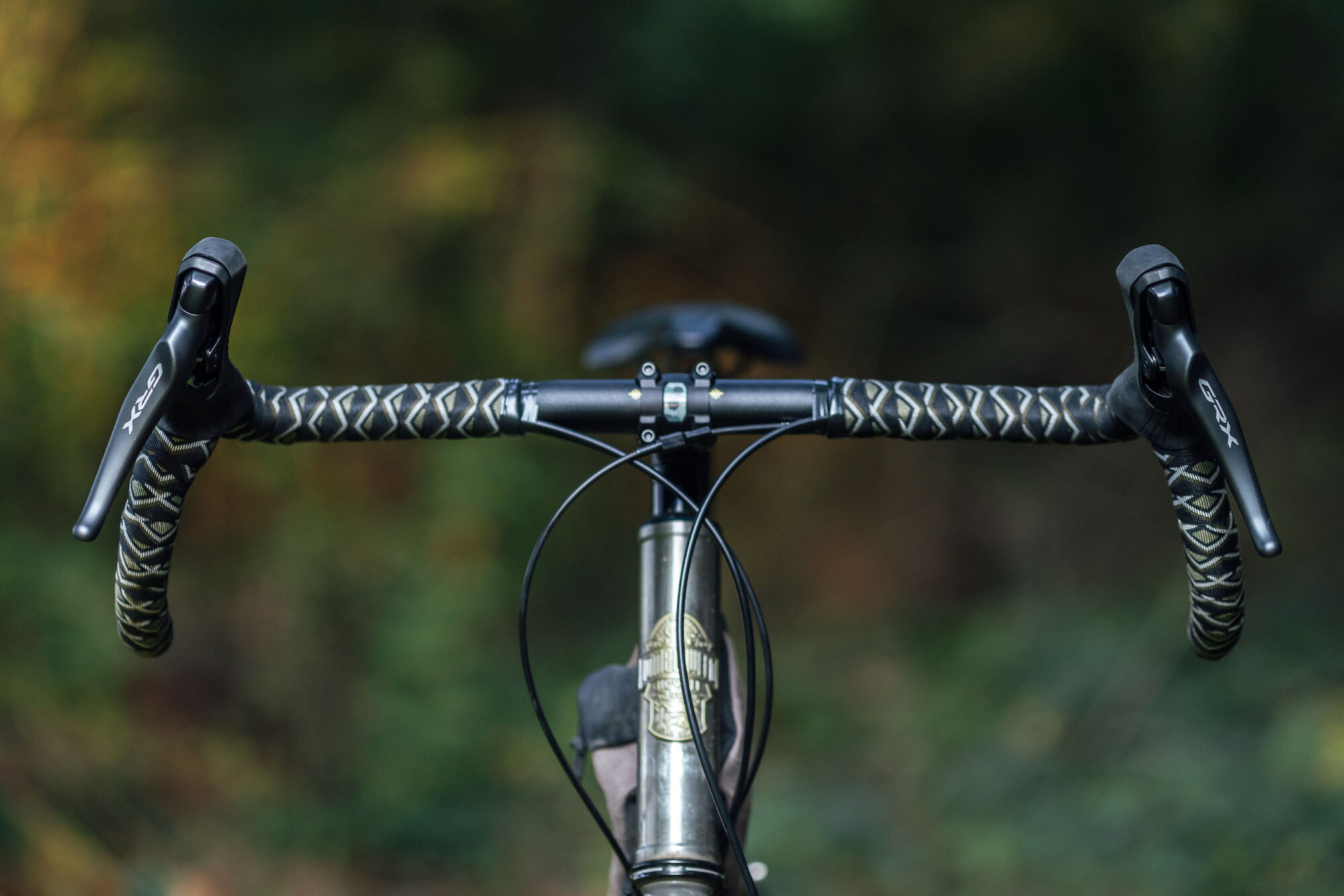
Once I got moving, all of these worries went away pretty quickly. I was impressed with the relatively light action on the shifter lever, and the dropper lever feels great. I also came to appreciate the large and flat brake levers that feel great for one-finger braking and have a really usable feel from multiple positions. The housing port bumps were also a welcome surprise. They create a comfy flat profile on the tops of the hoods, which is typically my hand placement priority.
Also, I might add that the GRX levers were redesigned with new ergonomics to work better with flared bars. As you can see in these photos, they have a great stance with flared bars too. The grippy hoods generally seem to offer a lot of position options compared to the old Rivals I’ve been running. All of the four hand positions shown here seemed to be my go-tos, and I spent a lot of time holding the ball of the hood with my fingers looped around the ergonomic shape in the front of the hood. I was still able to engage the brake levers in that more relaxed position, to a degree.
Speaking of the brakes, not much changed with the flat-mount GRX two-piston calipers. Shimano mentioned adding 10% more rotor clearance to reduce noise; I didn’t experience any noise, and they also worked surprisingly well when I got caught out riding in the rain one afternoon. Overall, I found the GRX brakes to offer predictable and fairly powerful stopping power and surprisingly good modulation for two-piston calipers.
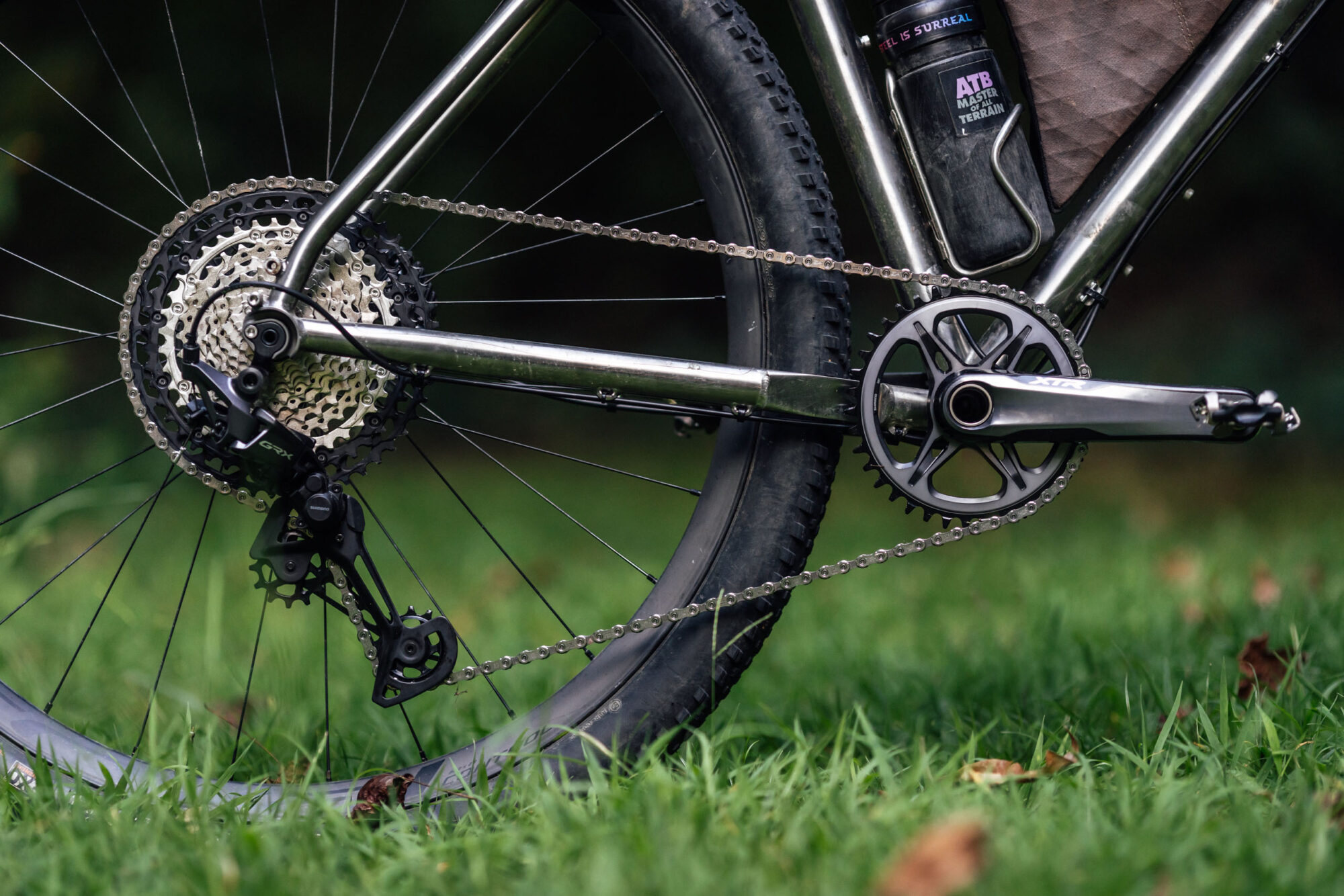
Shimano GRX 1×12 Cassettes and Gearing
Unfortunately, the only two chainring options for the GRX 1x crankset are 42T and 40T. Even when the latter is paired with the massive 51T cassette cog, the result might still be an intimidating granny gear for some folks, particularly when bikepacking and/or using it on a drop-bar mountain bike with bigger tires. That amounts to 22.4 gear inches with a 40T ring, 51T cassette cog, and 2.0” tires. It’s workable but maybe not ideal for everyone. That being said, there are crankset options, as mentioned in the Cross-Compatibility paragraph above.
I tried to emulate this gear as best as possible with a 38T chainring on the XTR crankset paired with 29 x 2.35” tires. That combo nets about 21.8 gear inches in the 51T cog. Note that 38T is Shimano’s biggest chainring available for their MTB cranksets. For gravel riding and general ATBing, I find the 38T ring to pair pretty well with the 10-51T cassette. I stayed within the mid-cassette cogs most of the time, which is not only good for chain and cassette lifespan, but it also results in some pretty good gear spacing in that middle range, as you can see in the diagram below.

That being said, I’d be quite curious about using the 10-45T cassette and mid-cage GRX derailleur for the styles of riding I like to do. With the same chainring, it provides more tightly spaced gearing for not-too-aggressive climbing, and swapping to a 34T ring offers pretty compelling ratios with the same granny gear. I think it’s horses for courses, in the long run, but the fact that the XT cassette offers tighter high gearing than the Eagle cassette I was used to seems advantageous.
Shimano GRX 12-speed vs. SRAM Apex
Lastly, since the recent SRAM Apex launch is fresh on everyone’s minds, let’s compare the two. They share a couple of key similarities and interesting differences. First, the two mechanical groups are both based solely on flat-mount hydraulic brakes, and both of their 1x cranksets only offer 40 and 42T chainring options. The most notable difference between the two is the fact that the Apex group provides a more cross-compatible baseline. For example, the crankset has a DUB spindle that fits both road and MTB (68 or 73mm) bottom brackets and works with standard or Boost hub spacing. As mentioned, that’s not a critical difference as you can substitute cranksets in either system.
More substantial is the fact that the Apex 12-speed derailleur has the same pull ratio as SRAM’s MTB shifters, providing the ability to swap between flat and drop bars, although that can get complicated with hydraulic flat-mount brakes. That being said, Apex is the sole mechanical group in SRAM’s road/gravel lineup and is clearly at the low-end of the range with the majority of SRAM’s mid and top-tier drivetrains moving to wireless AXS technology. Here’s a breakdown of weights and pricing. Note that the weights for GRX are actual whereas the Apex numbers came from their press release. Also, the cassette that’s specced for Apex is the GX Eagle cassette, for the sake of comparison.
| Apex Component | GRX 10-51 | APEX EAGLE | GRX 10-51 | APEX EAGLE |
|---|---|---|---|---|
| SHIFT/BRAKE SYSTEM RIGHT | $444.99 | $245 |
16.0 oz
453 g
|
16.8 oz
475 g
|
| SHIFT/BRAKE SYSTEM LEFT | $414.99 | $205 |
16.0 oz
453 g
|
13.9 oz
395 g
|
| DERAILLEUR | $126.99 | $125 |
10.4
294 g
|
10.2 oz
288 g
|
| CRANKSET | $249.99 | $110 |
22.6
640 g
|
24.8 oz
703 g
|
| CASSETTE | $164.99 | $231 |
16.5 oz
467 g
|
16 oz
453 g
|
| CHAIN | $48.99 | $28 |
8.7 oz
247 g
|
9.2 oz
260 g
|
| ROTORS | $121.98 | $108 |
8.0 oz
226 g
|
11.9 oz
336 g
|
| GROUP (no BB) | $1,572.92 | $1,052 |
6.13 lbs
2.78 kg
|
6.42 lbs
2.91 kg
|
Keep in mind that this is not comparing apples to apples, really. The Shimano components are XT-level, whereas the Apex components are at a lower range in SRAM’s lineup. You could easily sub the GRX 610 shifter levers and crankset and save $385, which brings the total of the GRX group to $1,187.92 and only adds about 175 grams, making it right in line with the Apex group. You could also swap for an SLX crankset to bring the cost down close to or below the Apex group.
The gear ratios are something else to consider. As you can see when comparing the two big cassettes below, SRAM maintains tighter ratios throughout the middle-top end of the cassette before jumping 10T in one massive final shift to the 52T cog. By comparison, Shimano’s 12-speed cassettes start to open up at the ninth gear and make bigger steps between the 28 and 39 tooth sprockets. You can read more about this on my XT review linked below.
Shimano XT: 10-12-14-16-18-21-24-28-33-39-45-51T
SRAM Eagle: 10-12-14-16-18-21-24-28-32-36-42-52T
For the mid-cage options, SRAM pairs theirs with the 11-44T cassette (which is only offered for the XDR freehub) and Shimano has the 10-45T cassette (Microspline). They are geared substantially differently. You can plug these into the Bike Gear Calculator to see how they compare.
SRAM 11-44T: 11-12-13-15-17-19-21-24-28-32-38-44
Shimano 10-45T: 10-12-14-16-18-21-24-28-32-36-40-45
Unfortunately, I haven’t ridden the new Apex system to compare the two from an experience standpoint. Some folks have a brand preference, either based on shifting qualities or the lever actuation—Shimano uses the entire lever to up-shift, and SRAM only uses the paddle. I’ve spent a fair amount of time on SRAM’s Rival group, and while I generally like it, I was impressed with the ergonomics and feel of the new GRX levers. There’s a lot of attention to detail that went into them. I’m also pretty blown away with how clean and quiet the shifting is with the 12-speed GRX group I’m testing. It will be hard to beat.

- Model Tested: Shimano GRX 12-speed, 800-series 1x
- Actual Weight: 2.78 kg (6.13 lbs)
- Place of Manufacture: Japan
- Price: $1,572.92
- Manufacturer’s Details: Shimano
Pros
- Silky smooth shifting that’s remarkably quiet and works well under load
- Two good wide-range options for 1×12-speed cassettes that work with MicroSpline freehub standard
- Nice ergonomics and lever feel, for both shifting and dropper actuation
- Sharp and minimal aesthetics
- Mineral oil brakes that work very well
- Chain and cassette proved themselves incredibly long-lasting and durable during our long-term XT test
- Happy to see Shimano go completely plastic-free in their new packaging
Cons
- Levers not available for mechanical brakes
- Derailleur pull ratio is different than Shimano 12-speed MTB shifters
- GRX crankset doesn’t work with 73mm BB, and only available with a 40 or 42T chainring (although 600-series has a 38T option)
- Derailleur clutch may need regular servicing (verdict is out on this)
- Expensive compared to SRAM Apex (but not apples to apples, as stated)
Wrap Up
If you’re a regular reader of our reviews, you may have noticed my partiality toward mountain bike parts and standards. I’m always in favor of new off-road-oriented bikes, including “gravel” bikes being built with Boost hub spacing, wider rims, 73mm bottom bracket shells, and bigger tire clearance. This is in part because it jives with my parts bin and riding preferences, but also because it just makes sense in a lot of cases. With that at the front of my subconscious, I was happy to hear that the new Shimano GRX 12-speed 1x groups were built around their mountain bike cassettes and that there are options for using HG-based cassettes and other cranksets.
Shimano’s decision to make it available solely with flat-mount hydraulic brakes and the lack of compatibility with MTB shifters were two significant bummers, but I’m still very impressed with the system overall. The GRX 12-speed derailleur paired with the XT cassette is one of—if not the—cleanest and quietest drivetrains I’ve used. The gear ratio combinations are nice too. And I was equally impressed with the ergonomics and feel of the new levers, both for shifting and dropper actuation.
Further Reading
Make sure to dig into these related articles for more info...
Please keep the conversation civil, constructive, and inclusive, or your comment will be removed.







